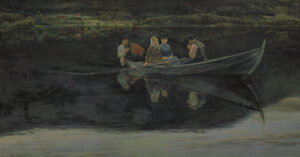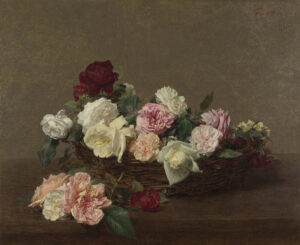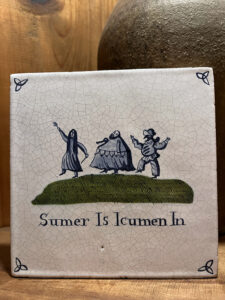Summer arrived here in Lake Worth about three weeks ago: where it had been warm but dry all through April and early May, suddenly one morning it was warm and humid and not dry and while I was hopeful for about a week that the dry air might return, by now I’ve stopped checking the weather forecast. There’s no longer any point to that. It’s Florida and this is our burden for the next four or five months: heat and humidity, of the constant sort. If you like predictability, you will love a Florida summer.
Summer sets in here and it takes a bit of getting accustomed to but then not long after comes St. John’s Eve and Old Midsummer, and these are days and nights I look forward to. We can count on a Midsummer bonfire at the Finnish-American Village west of town, and sometimes we will pick up a Midsummer feast to go from Johan’s Jöe, the Swedish coffee shop in West Palm Beach. I might read A Midsummer Night’s Dream, and we will sit down and watch some version of it, too, and the music from Felix Mendelssohn’s ballet will be on heavy rotation in our house. I’ll watch for nighttime blooms from the Guiana Chestnut tree in the backyard, blooms that pop open with a small explosion at about 9 in the evening and fill the thick humid air with fragrance: spiced, the same spice I imagine the Fairy Queen Titania described as she spoke about “the spiced Indian air, by night” in that same Midsummer Night’s Dream. If there’s magic to be found at Midsummer, it is found here in this strange green land, as easily as it is found in the Nordic lands where twilight runs its course through what little night there is in June.
Once Midsummer passes, I am pretty much done with a Florida summer… but alas, I make do, for what else can I do? There is beauty about it, to be sure. It’s just not always easy to remember to look for it.
For now, we are on the approach to Midsummer’s arrival: June has arrived, and the Midsummer Solstice here in the Northern Hemisphere comes in three weeks’ time, followed quickly by its accompanying holidays of St. John’s Eve on the 23rd and St. John’s Day on the 24th. All of these days are part of your Convivio Book of Days Calendar for June. It is, as usual, a printable PDF, a fine companion to this blog, and our gift to you. Cover star this month: an 1886 oil painting by Christian Skredsvig, called “Skt. Hans Aften i Norge” (or, in English, “St. John’s Eve in Norway”). In it, four folks are out on a boat on the still, reflective waters. It may very well be midnight, but there is no darkness, only light. How magical is that?
COME SEE US AT THE SHOP!
We’re open for Father’s Day Shopping (not to mention gifts for grads, too) TODAY: Sunday June 1, from 11 AM to 4 PM. Locals, please come visit: the shop is at 1110 North G Street, Lake Worth Beach 33460. We won’t be open very much in June, so this will be one of your few opportunities to come by this month. In the Creative Workshops department, we’ve got Kim Spivey teaching a new session of Collagraph Printmaking on Sunday July 27… this also happens to make a great gift. We love a gift that is an experience!
Top Image: “Skt. Hans Aften i Norge” by Christian Skredsvig. Oil on canvas, 1886 [Public domain via Wikimedia Commons].






